Planning worship?
Check out our sister site, ZeteoSearch.org,
for 20+ additional resources related to your search.
- |
User Links
Person Results
John Byrom
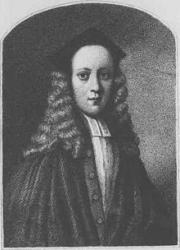
1692 - 1763 Person Name: John Byrom, 1692-1763 Translator of "Come, Saviour Jesus, from above" in Methodist Hymn and Tune Book John Byrom was born in 1691, at Manchester, where his father was a linen-draper. He entered Trinity College, Cambridge, 1708; became a Fellow of the College in 1714; took his M.A. in 1716, and then proceeded to Montpelier, where he studied medicine. He afterwards abandoned medicine, settled in London, and obtained his living by teaching a system of shorthand, which he had projected. He was elected a member of the Royal Society in 1724. He died Sept. 28, 1763. The first edition of Byrom's poems appeared in 1773, in two volumes. A more complete edition was published in 1814. Byrom did not seek publicity as an author, but wrote verses only for recreation.
--Annotations of the Hymnal, Charles Hutchins, M.A., 1872
======================
Byrom, John, M.A., F.R.S., born at Manchester, Feb. 29,1691-2, baptized the same day, and educated at Merchant Taylors' School, and Trinity College, Cambridge, where he graduated B.A. 1712 ; M.A. 1715. He was elected a Fellow of his College in 1714. After studying medicine for a time at Montpellier, he returned to London, and earned his livelihood by teaching shorthand. Elected F.R.S. in 1724, and succeeded to the family estates about the same time. He died Sept. 28, 1763. His Poems were first published in 1773, in two volumes. In 1814 a more complete edition was issued by Nichols, of Leeds. From these Poems less than half a dozen hymns have come into common use. One of these, however, has a repu¬tation which has extended to all English-speaking countries. We refer to his "Christians, awake!" (q.v.). His hymn, "My spirit longeth for Thee," is also worthy of attention.
-- John Julian, Dictionary of Hymnology (1907)
John Byrom
Samuel Longfellow
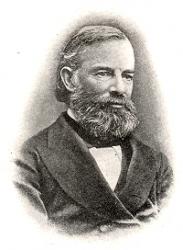
1819 - 1892 Author of "Again, as evening's shadow falls" in The Epworth Hymnal Longfellow, Samuel, B. A., brother of the Poet, was born at Portland, Maine, June 18, 1819, and educated at Harvard, where he graduated in Arts in 1839, and in Theology in 1846. On receiving ordination as an Unitarian Minister, he became Pastor at Fall River, Massachusetts, 1848; at Brooklyn, 1853; and at Germantown, Pennsylvania, 1860. In 1846 he edited, with the Rev. S. Johnson (q. v.), A Book of Hymns for Public and Private Devotion. This collection was enlarged and revised in 1848. In 1859 his Vespers was published, and in 1864 the Unitarian Hymns of the Spirit , under the joint editorship of the Rev. S. Johnson and himself. His Life of his brother, the Poet Longfellow, was published in 1886. To the works named he contributed the following hymns:—
i. To A Book of Hymns , revised ed., 1848.
1. Beneath the shadow of the Cross. Love.
2. 0 God, thy children gathered here. Ordination.
ii. To the Vespers 1859.
3. Again as evening's shadow falls. Evening.
4. Now on land and sea descending. Evening.
iii. To the Hymns of the Spirit, 1864.
5. A voice by Jordan's shore. Advent.
6. Father, give Thy benediction. Ordination.
7. Go forth to life, 0 child of earth. Life's Mission.
8. God of ages and of nations. Holy Scriptures.
9. Holy Spirit, Truth divine. The Holy Spirit desired.
10. I look to Thee in every need. Trust in God.
11. In the beginning was the Word. The Word.
12. Love for all, and can it be? Lent. The Prodigal Son.
13. 0 God, in Whom we live and move. God's Law and Love.
14. 0 God, Thou Giver of all good. Prayer for Food.
15. O still in accents sweet and strong. Missions.
16. 0 Thou, Whose liberal sun and rain. Anniversary of Church dedication.
17. One holy Church of God appears. The Church Universal.
18. Out of the dark, the circling sphere. The Outlook.
19. Peace, peace on earth! the heart of man for ever. Peace on Earth.
20. The loving Friend to all who bowed. Jesus of Nazareth.
21. ’Tis winter now, the fallen snow. Winter.
Of these, hymn No. 2 was written for the Ordination of E. E. Hale (q. v.), at Worcester, 1846. Several are included in Martineau's Hymns, 1873.
Died Oct. 3, 1892. [Rev. F. M. Bird, M.A.]
--John Julian, Dictionary of Hymnology (1907), p. 685
===============
Longfellow, S., p. 685, i. Since Mr. Longfellow's death on Oct. 3, 1892, his hymns have been collected by his niece, Miss Alice Longfellow, as Hymns and Verses(Houghton, Mifflin & Co., 1904.) From this work we find many of the hymns signed Anon, in the Index to Longfellow and Johnson's Hymns of the Spirit, 1864, were his; several of these, including E. Osier's "O God unseen, yet ever near," were popular English hymns which he rewrote from his own theological standpoint. These re¬written hymns are very widely used by Unitarians and others. During the last ten years the following additional hymns by S. Long¬fellow have come into common use:—
1. Eternal One, Thou living God. Faith in God.
2. God of the earth, the sky, the sea. God in Nature.
3. God's trumpet wakes the slumbering world. Call to duty.
4. Light of ages and of nations. God in and through all time.
5. Lo, the earth is risen again. Spring. (1876.)
6. Now while we sing our closing psalm. Close of Worship.
7. O Life that maketh all things new. Unity. (1874.)
8. O Thou in Whom we live and move. The Divine Law.
9. The summer days are come again. Summer. From his hymn,"The sweet[bright] June days are come again."
10. Thou Lord of lite, our saving health. In Sickness. (1886.)
Of these hymns Nos. 2, 3 appeared in the Hymns of the Spirit, 1864, and all with the dates appended in Hymns and Verses, 1904.
--John Julian, Dictionary of Hymnology, New Supplement (1907)
==================
http://en.wikipedia.org/wiki/Samuel_Longfellow
Samuel Longfellow
John Wesley
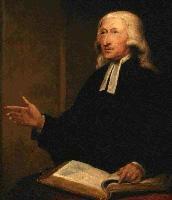
1703 - 1791 Person Name: J. Wesley Translator of "Jesus, Thy boundless love to me" in Songs for the Lord's House John Wesley, the son of Samuel, and brother of Charles Wesley, was born at Epworth, June 17, 1703. He was educated at the Charterhouse, London, and at Christ Church, Oxford. He became a Fellow of Lincoln College, Oxford, and graduated M.A. in 1726. At Oxford, he was one of the small band consisting of George Whitefield, Hames Hervey, Charles Wesley, and a few others, who were even then known for their piety; they were deridingly called "Methodists." After his ordination he went, in 1735, on a mission to Georgia. The mission was not successful, and he returned to England in 1738. From that time, his life was one of great labour, preaching the Gospel, and publishing his commentaries and other theological works. He died in London, in 1791, in his eighty-eighth year. His prose works are very numerous, but he did not write many useful hymns. It is to him, however, and not to his brother Charles, that we are indebted for the translations from the German.
--Annotations of the Hymnal, Charles Hutchins, M.A., 1872
======================
John Wesley, M.A., was born at Epworth Rectory in 1703, and, like the rest of the family, received his early education from his mother. He narrowly escaped perishing in the fire which destroyed the rectory house in 1709, and his deliverance made a life-long impression upon him. In 1714 he was nominated on the foundation of Charterhouse by his father's patron, the Duke of Buckingham, and remained at that school until 1720, when he went up, with a scholarship, from Charterhouse to Christ Church, Oxford. Having taken his degree, he received Holy Orders from the Bishop of Oxford (Dr. Potter) in 1725. In 1726 he was elected Fellow of Lincoln College, and remained at Oxford until 1727, when he returned into Lincolnshire to assist his father as curate at Epworth and Wroot. In 1729 he was summoned back to Oxford by his firm friend, Dr. Morley, Rector of Lincoln, to assist in the College tuition. There he found already established the little band of "Oxford Methodists" who immediately placed themselves under his direction. In 1735 he went, as a Missionary of the Society for the Propagation of the Gospel, to Georgia, where a new colony had been founded under the governorship of General Oglethorpe. On his voyage out he was deeply impressed with the piety and Christian courage of some German fellow travellers, Moravians. During his short ministry in Georgia he met with many discouragements, and returned home saddened and dissatisfied both with himself and his work; but in London he again fell in with the Moravians, especially with Peter Bohler; and one memorable night (May 24, 1738) he went to a meeting in Aldersgate Street, where some one was reading Luther's preface to the Epistle to the Romans. There, "About a quarter before nine, while he was describing the change which God works in the heart through faith in Christ, I felt my heart strangely warmed. I felt I did trust in Christ, Christ alone, for salvation; and an assurance was given me, that He had taken away my sins, even mine, and saved me from the law of sin and death." From that moment his future course was sealed; and for more than half a century he laboured, through evil report and good report, to spread what he believed to be the everlasting Gospel, travelling more miles, preaching more sermons, publishing more books of a practical sort, and making more converts than any man of his day, or perhaps of any day, and dying at last, March 2, 1791, in harness, at the patriarchal age of 88.
The popular conception of the division of labour between the two brothers in the Revival, is that John was the preacher, and Charles the hymnwriter. But this is not strictly accurate. On the one hand Charles was also a great preacher, second only to his brother and George Whitefield in the effects which he produced. On the other hand, John by no means relegated to Charles the exclusive task of supplying the people with their hymns. John Wesley was not the sort of man to depute any part of his work entirely to another: and this part was, in his opinion, one of vital importance. With that wonderful instinct for gauging the popular mind, which was one element in his success, he saw at once that hymns might be utilized, not only for raising the devotion, but also for instructing, and establishing the faith of his disciples. He intended the hymns to be not merely a constituent part of public worship, but also a kind of creed in verse. They were to be "a body of experimental and practical divinity." "In what other publication," he asks in his Preface to the Wesleyan Hymn Book, 1780 (Preface, Oct. 20,1779), "have you so distinct and full an account of Scriptural Christianity; such a declaration of the heights and depths of religion, speculative and practical; so strong cautions against the most plausible errors, particularly those now most prevalent; and so clear directions for making your calling and election sure; for perfecting holiness in the fear of God?" The part which he actually took in writing the hymns, it is not easy to ascertain; but it is certain that more than thirty translations from the German, French and Spanish (chiefly from the German) were exclusively his; and there are some original hymns, admittedly his composition, which are not unworthy to stand by the side of his brother's. His translations from the German especially have had a wide circulation. Although somewhat free as translations they embody the fire and energy of the originals.
It has been the common practice, however for a hundred years or more to ascribe all translations from the German to John Wesley, as he only of the two brothers knew that language; and to assign to Charles Wesley all the original hymns except such as are traceable to John Wesley through his Journals and other works.
The list of 482 original hymns by John and Charles Wesley listed in this Dictionary of Hymnology have formed an important part of Methodist hymnody and show the enormous influence of the Wesleys on the English hymnody of the nineteenth century.
-- Excerpts from John Julian, Dictionary of Hymnology (1907)
===================
See also in:
Hymn Writers of the Church
John Wesley
Johann Baptist von Albertini
1769 - 1831 Person Name: J. B. v. Albertini Author of "Mit Deiner Gluth entzünde mich" in Die Glaubensharfe (With Melodies) Albertini, Johann Baptist. s. of Jakob Ulrich v. Albertini, a native of the Grisons, Switzerland, who had joined the Moravians, and settled among them at Neuwied, near Coblenz, b. at Neuwied Feb. 17, 1769. After passing through the Moravian school at Niesky, and their Theological Seminary at Barby, in both of, which he had Friedrich Schlciermacher as a fellow-student, he was, in 1788, appointed one of the masters in the Moravian school at Niesky, and in 1789 at Barby. In 1796, he was appointed tutor at the Theological Seminary at Niesky, and ordained as diaconus of the Moravian Church. Up to this time he had devoted himself chiefly to the study of the Oriental languages, and of botany, but now his studies of Holy Scripture for his theological lectures and for the pulpit, brought him to the feet of Christ, whose earnest and devoted disciple and witness he henceforth became. In 1804 he relinquished his tutorial work to devote himself entirely to ministerial labour in Niesky, where he was, in 1810, ordained presbyter. In Feb. 1814 he went to Gnadenberg, near Bunzlau, Silesia, as head of the Girls' School, and preacher; and while on a visit to Herrnhut, was, Aug. 24, 1814, constituted a bishop of the Moravian Church. By the synod of 1818, he was appointed to Gnadenfrei, near Reichenbach, Silesia, and after three years of faithful and successful labour, was chosen one of the heads of the Moravian Church (one of the UnitatS'Aeltesten-Conferenz), his special department being the oversight of their charitable and educational establishments ; and in 1824 President of the Conference. In love and meekness he ruled and visited the churches till, in Nov. 1831, an illness seized him, which terminated fatally at Berthelsdorf, near Herrnhut, Dec. 6, 1831. (Koch, vii. 330-334; Allg. Deutsche Biog., i. 216-217.) Distinguished as a preacher beyond the bounds of his church, he was, in the estimation of Koch, apart from Novalis, the most important hymn-writer of his time— spiritual, simple, and childlike. Yet it must be said that his brother Moravian, G. B. Garve, and E. M. Arndt, are more fully represented in hymnals since 1820. Albertini's hymns appeared to the number of 400, (many, however, being single verses,) in his Geistliche Lieder fur Mitglieder und Freunde der Bruder-yemeine, Bunzlau, 1821 (2nd ed. 1827). None of them have passed into English common use, and the only three we have to note are:—
i. Brenne hell, du Lampe meiner Seele. [Second Advent.] On the Lamp of the Wise Virgin. 1st pub. 1821, as above, p. 139, in 3 stanzas of 8 lines. The only translation is, "Lamp within me! brightly burn and glow," by Miss Winkworth, 1869, p. 311.
ii. Freund, komm in der Fruhe. [Morning.] 1st pub. 1821, as above, p. 273, in 5 st. of 10 1. Tr. as, " Come at the morning hour," by Miss Borthwick in Hymns from the Land of Luther 1862 (cd. 1862, p. 256; 1884, p. 190).
iii. Langst suchtest du, mein Geist! ein nahes Wesen. [Christmas.] 1st pub. 1821, as above, p. 9, in 5 stanzas of 6 lines. Translated as, "Long in the spirit world my soul had sought," by Miss Winkworth, 1855, p. 191 (later eds. p. 193), assigned to St. Thomas's Day.
-John Julian, Dictionary of Hymnology (1907)
Johann Baptist von Albertini
Eliza Holmes Reed
1794 - 1867 Person Name: Mrs. Elizabeth Reed Author of "Oh, do not let the word depart" in The Songs of Zion Reed, Eliza, née Holmes, was born in London, March 4, 1794; married to the Rev. Andrew Reed in 1816; and died July 4, 1867. Mrs. Reed entered fully and earnestly into her husband's extensive charitable works. Her publications include Original Tales for Children; and The Mother's Manual for the Training of her Children, 1865. Her hymns, 20 in all, were contributed to her husband's collection, and were republished with his in the Wycliffe Chapel Supplement, 1872. They are only of average merit, and have not attained to a marked position. They include:—
1. Gracious Lord, as Thou hast bidden. Holy Baptism.
2. I would be Thine, 0 take my heart . Dedication of Self to Christ.
3. 0 do not let the word depart. The Accepted Time.
4. 0 that I could for ever dwell. Communion with God Desired.
--John Julian, Dictionary of Hymnology (1907)
Eliza Holmes Reed
Oliver Wendell Holmes
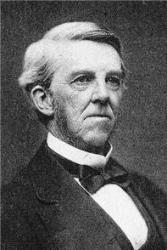
1809 - 1894 Person Name: Oliver W. Holmes Author of "O Love Divine" in The Popular Hymnal Holmes, Oliver Wendell, M.D, LL.D., son of the Rev. Abiel Holmes, D.D. of Cambridge, U.S.A., was born at Cambridge, Aug. 29, 1809, and educated at Harvard, where he graduated in 1829. After practising for some time in Boston, he was elected in 1847 to the chair of Anatomy, in Harvard. His writings in prose and verse are well known and widely circulated. They excel in humour and pathos. Although not strictly speaking a hymnwriter, a few of his hymns are in extensive use, and include:—
1. Father of mercies, heavenly Friend. Prayer during war.
2. Lord of all being, throned afar. God's Omnipresence. This is a hymn of great merit. It is dated 1848.
3. 0 Lord of hosts, Almighty King. Soldiers’ Hymn. Dated 1861.
4. 0 Love divine that stoop'st to share. Trust. 1859.
Of these Nos. 2 and 4 are in his Professor at the Breakfast Table, and are in common use in Great Britain, in Martineau's Hymns, 1873, and others. In 1886 the D.C.L. degree was conferred upon Professor Holmes by the University of Oxford. He was a member of the Unitarian body. He died Oct 7, 1894. [Rev. F. M. Bird, M.A.]
--John Julian, Dictionary of Hymnology (1907)
==================
Holmes, O. W. , p. 530, i. His Songs in Many Keys was published in 1861, his Poems, 1869, and the Cambridge edition of his Complete Poetical Works, 1895. Additional hymns of his have come into common use of late, including:—
1. Land where the banners wave last in the sun. [American National Hymn.] Appeared in his Songs in Many Keys, 1861 (7th ed. 1864, p. 289) as "Freedom, our Queen."
2. Lord, Thou hast led us as of old. [Promised Unity.] In his Before the Curfew and other Poems, chiefly occasional, Boston, 1888, as "An hymn set forth to bo sung by the Great Assembly at Newtown [Mass.]." In the Complete Poetical Works it is dated 1886. The hymn "Soon shall the slumbering morn awake," in Hymns for Church and Home, Boston, 1895, is composed of stanzas v.-vii.
3. Our Father, while our hearts unlearn The creeds that wrong Thy name. [Fruits of the Spirit.] Written for the 25th Anniversary Reorganization of the Poston Young Men's Christian Union, May 31, 1893. In his Complete Poetical Works, 1895, p. 298, Horder's Worship Song, 1905, and other collections.
4. Thou gracious [God] Power Whose mercy lends. [Reunion.] "Written for the annual meeting of the famous class '29, Harvard University, in 1869. ln the Methodist Hymn Book, 1904, it begins "Thou gracious God, Whose mercy lends." [Rev. L. F. Benson, D.D.]
--John Julian, Dictionary of Hymnology, New Supplement (1907)
Oliver Wendell Holmes
J. Grigg
1720 - 1768 Person Name: Joseph Grigg Author of "Behold! a stranger's at the door" in The Hymnal Grigg, Joseph, was born in 1728, according to the D. Sedgwick’s Manuscript," but this date seems to be some six or eight years too late. He was the son of poor parents and was brought up to mechanical pursuits. In 1743 he forsook his trade and became assistant minister to the Rev. Thomas Bures, of the Presbyterian Church, Silver Street, London. On the death of Mr. Bures in 1747, he retired from the ministry, and, marrying a lady of property, look up his residence at St. Albans. He died at Walthamstow, Essex, Oct. 29, 1768. As a hymnwriter Grigg is chiefly known by two of his hymns, "Behold a stranger at the door"; and "Jesus, and can it ever be?" His hymnwriting began, it is said, at ten years of age. His published works of various kinds number over 40. Those in which his hymns are found are:—
(1) Miscellanies on Moral and Religious Subjects, &c, London, Elizabeth Harrison, 1756. (2) The Voice of Danger, the Voice of God. A Sermon Preached at St. Albans, and at Box-Lane, Chiefly with a View to the apprehended Invasion. By J. Grigg. London, J. Buckland, 1756. To this is appended his hymn, "Shake, Britain, like an aspen shake." (3) Four Hymns on Divine Subjects wherein the Patience and Love of Our Divine Saviour is displayed, London, 1765. (4) Hymns by the late Rev. Joseph Grigg, Stourbridge, 1806. (5) During 1765 and 1766 he also contributed 12 hymns to The Christians Magazine.
In 1861 D. Sedgwick collected his hymns and poems, and published them with a memoir as:
Hymns on Divine Subjects, * * * * London, 1861. This volume contains 40 "Hymns," and 17 "Serious Poems." In the “S. MSS." Sedgwick notes that in 1861 he omitted three hymns by Grigg, which were then unknown to him, viz.:—l) On "The National Fast," appended to a sermon preached at Northampton, Feb. 13, 1761, by W. Warburton, and published in London, 1761. (2) "A Harvest Hymn by the late Rev. Joseph Grigg," in 6 stanzas, in the Evangelical Magazine, July, 1822; and (3) On the Parable of Dives and Lazarus, dated "Feb. 15, 1767."
-- John Julian, Dictionary of Hymnology (1907)
J. Grigg
Aaron R. Wolfe
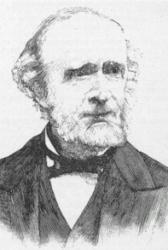
1821 - 1902 Person Name: Rev. Aaron Robarts Wolfe Author of "Draw near, O Holy Dove, draw near" in Songs of Work and Worship Wolfe, Aaron Robarts, was born at Mendham, New Jersey, Sep. 6, 1821, and educated at Williams College, 1844; and the Union Theological Seminary, New York, 1851. On April 9, 1851, he was licensed by the Third Presbytery of New York. For some lime he had charge of a school for young ladies at Tallahassee, Florida; and in 1859 he established "The Hillside Seminary for Young Ladies" at Montclair, New Jersey. In 1858 he contributed 7 hymns under the signature "A. R. W." to Hastings's Church Melodies. These are:—
1. A Parting hymn we sing. Close of Holy Communion.
2. Complete in Thee, no work of mine. Complete in Christ. Published in the N. Y. Evangelist, 1850 or 51.
3. Draw near, O Holy Dove, draw near. Holy Communion.
4. How blest indeed are they. In the Likeness of Christ.
5. My God, I thank Thee for the guide. Conscience.
6. Mysterious influence divine. The Cross of Christ.
7. Thou Maker of our mortal frame. Chief end of Man.
The most popular of these hymns are Nos. 1, 2, and 3. [Rev. F. M. Bird, M.A.]
-- John Julian, Dictionary of Hymnology (1907)
Aaron R. Wolfe


 My Starred Hymns
My Starred Hymns

